Dynamic Evaluation for Subway–Bus Transfer Quality Referring to Benefits, Convenience, and Reliability
Abstract
1. Introduction
2. Indices for Bus–Subway Transfer Evaluation
2.1. Transfer Benefits
2.2. Transfer Convenience
2.3. Transfer Reliability
3. Data Extraction and Dynamic Evaluation Method
3.1. Logical Framework and Multi-Source Data
3.2. Dynamic Evaluation Method
4. Case Study and Results Discussion
4.1. Case Study Area and Transit System
4.2. Results Discussion
4.3. Implications and Recommendations
5. Conclusions
Author Contributions
Funding
Institutional Review Board Statement
Informed Consent Statement
Data Availability Statement
Conflicts of Interest
References
- Seaborn, C.; Attanucci, J.; Wilson, N.H.M. Analyzing multimodal public transport journeys in London with smart card fare payment data. Transp. Res. Rec. 2009, 2121, 55–62. [Google Scholar] [CrossRef]
- Currie, G. Quantifying spatial gaps in public transport supply based on social needs. J. Transp. Geogr. 2010, 18, 31–41. [Google Scholar] [CrossRef]
- Garcia-Martinez, A.; Cascajo, R.; Jara-Diaz, S.R.; Chowdhury, S.; Monzon, A. Transfer penalties in multimodal public transport networks. Transp. Res. Part A Policy Pract. 2018, 114, 52–66. [Google Scholar] [CrossRef]
- Mohring, H.; Schroeter, J.; Wiboonchutikula, P. The values of waiting time, travel time, and a seat on a bus. RAND J. Econ. 1987, 18, 40–56. [Google Scholar] [CrossRef]
- Liu, Z. Evaluating the dynamic resilience of the multi-mode public transit network for sustainable transport. J. Clean. Prod. 2022, 348, 131350. [Google Scholar] [CrossRef]
- Liu, Z. Resilience-based post-disaster repair strategy for integrated public transit networks. Transp. B Transp. Dyn. 2024, 12, 1–25. [Google Scholar] [CrossRef]
- Liu, X. How to make service better? A review on developing service-oriented public transit systems. Transp. Rev. 2025, 1–24. [Google Scholar] [CrossRef]
- Zhao, J. Joint optimisation of regular and demand-responsive transit services. Transp. A Transp. Sci. 2023, 19, 1987580. [Google Scholar] [CrossRef]
- Carrel, A.; Halvorsen, A.; Walker, J.L. Passengers’ perception of and behavioral adaptation to unreliability in public transportation. Transp. Res. Rec. 2013, 2351, 153–162. [Google Scholar] [CrossRef]
- Chen, J.; Liu, H.; Ma, Y.; Li, X. Performance evaluation of bus transfer nodes based on Advanced Public Transportation System data. In Proceedings of the International Conference on Smart Transportation and City Engineering, Chongqing, China, 10 November 2021; Volume 12050, pp. 491–496. [Google Scholar]
- Fan, A.; Chen, X.; Wang, Y.; Kou, W. All-stop, skip-stop, or transfer service: An empirical study on preferences of bus passengers. IET Intell. Transp. Syst. 2018, 12, 1255–1263. [Google Scholar] [CrossRef]
- Basbas, S. Evaluation of bus transfer stations from the passenger’s point of view. WIT Trans. Built Environ. 2006, 89, 10. [Google Scholar] [CrossRef]
- Weng, J.; Di, X.; Wang, C.; Wang, J.; Mao, L. A bus service evaluation method from passenger’s perspective based on satisfaction surveys: A Case Study Beijing China. Sustain 2018, 10, 2723. [Google Scholar] [CrossRef]
- Kim, C.; Kim, S.W.; Kang, H.J.; Song, S.M. What makes urban transportation efficient? Evidence from subway transfer stations in Korea. Sustainability 2017, 9, 2054. [Google Scholar] [CrossRef]
- Ye, J.; Chen, J.; Bai, H.; Yue, Y. Analyzing transfer commuting attitudes using a market segmentation approach. Sustainability 2018, 10, 2194. [Google Scholar] [CrossRef]
- Sadhukhan, S.; Banerjee, U.K.; Maitra, B. Commuters’ perception towards transfer facility attributes in and around subway stations: Experience in Kolkata. J. Urban Plan. Dev. 2015, 141, 04014038. [Google Scholar] [CrossRef]
- Kim, J.; Schmöcker, J.D.; Yu, J.W.; Choi, J.Y. Service quality evaluation for urban rail transfer facilities with Rasch analysis. Travel Behav. Soc. 2018, 13, 26–35. [Google Scholar] [CrossRef]
- Sil, A.; Chaniotakis, E.; Roy, U.K.; Antoniou, C. Exploring satisfaction for transfers at intermodal interchanges: A comparison of Germany and India. J. Public Transp. 2022, 24, 100005. [Google Scholar] [CrossRef]
- Cherry, T.; Townsend, C. Assessment of potential improvements to subway–bus transfers in Bangkok, Thailand. Transp. Res. Rec. 2012, 2276, 116–122. [Google Scholar] [CrossRef]
- Chauhan, V.; Gupta, A.; Parida, M. Demystifying service quality of Multimodal Transportation Hub (MMTH) through measuring users’ satisfaction of public transport. Transp. Policy 2021, 102, 47–60. [Google Scholar] [CrossRef]
- Huang, H.; Ji, C. Evaluation of Different Traffic Modes Connecting Regional Metro Stations--A case study in Dishui Lake Station. Highlights Sci. Eng. Technol. 2023, 37, 89–96. [Google Scholar] [CrossRef]
- Yang, M.; Zhao, J.; Wang, W.; Liu, Z.; Li, Z. Subway commuters’ satisfaction in multi-type access and egress transferring groups. Transp. Res. Part D Transp. Environ. 2015, 34, 179–194. [Google Scholar] [CrossRef]
- Wu, P.; Xu, L.; Zhong, L.; Gao, K.; Qu, X.; Pei, M. Revealing the determinants of the intermodal transfer ratio between subway and bus systems considering spatial variations. J. Transp. Geogr. 2022, 104, 103415. [Google Scholar] [CrossRef]
- Cheng, Y.H.; Tseng, W.C. Exploring the effects of perceived values, free bus transfer, and penalties on intermodal subway–bus transfer users’ intention. Transp. Policy 2016, 47, 127–138. [Google Scholar] [CrossRef]
- Chen, Z.; Huang, Z.; Yang, L.; Zheng, P. Evaluation of Transfer Efficiency between Subway and Bus Based on the Interval Number Ranking Method by Employing Probability Reliability: Taking Ningbo for Example. Discret. Dyn. Nat. Soc. 2021, 2021, 9125605. [Google Scholar] [CrossRef]
- Wang, W.; Wang, Y.; Correia, G.H.A.; Chen, Y. A network-based model of passenger transfer flow between bus and metro: An application to the public transport system of Beijing. J. Adv. Transp. 2020, 2020, 6659931. [Google Scholar] [CrossRef]
- Liu, D.; Rong, W.; Zhang, J.; Ge, Y.E. Exploring the Nonlinear Effects of Built Environment on Bus-Transfer Ridership: Take Shanghai as an Example. Appl. Sci. 2022, 12, 5755. [Google Scholar] [CrossRef]
- Chen, E.; Ye, Z.; Wang, C.; Zhang, W. Discovering the spatio-temporal impacts of built environment on metro ridership using smart card data. Cities 2019, 95, 102359. [Google Scholar] [CrossRef]
- Chakrabarti, S.; Giuliano, G. Does service reliability determine transit patronage? Insights from the Los Angeles Metro bus system. Transp. Policy 2015, 42, 12–20. [Google Scholar] [CrossRef]
- Ceder, A.; Le Net, Y.; Coriat, C. Measuring public transport connectivity performance applied in Auckland, New Zealand. Transp. Res. Rec. 2009, 2111, 139–147. [Google Scholar] [CrossRef]
- Suman, H.K.; Bolia, N.B. A review of service assessment attributes and improvement strategies for public transport. Transp. Dev. Econ. 2019, 5, 1. [Google Scholar] [CrossRef]
- Lee, E.H.; Lee, H.; Kho, S.Y.; Kim, D.K. Evaluation of transfer efficiency between bus and subway based on data envelopment analysis using smart card data. KSCE J. Civ. Eng. 2019, 23, 788–799. [Google Scholar] [CrossRef]
- Wu, P.; Li, J.; Pian, Y.; Li, X.; Huang, Z.; Xu, L.; Li, G.; Li, R. How Determinants Affect Transfer Ridership between Subway and Bus Systems: A Multivariate Generalized Poisson Regression Analysis Method. Sustainability 2022, 14, 9666. [Google Scholar]
- Gu, H.; Ren, Z. Operation and Planning of Hangzhou Subway Lines--Route Planning Based on Analytic Hierarchy Process. Highlights Sci. Eng. Technol. 2023, 37, 370–379. [Google Scholar] [CrossRef]
- Chen, S.; Leng, Y.; Mao, B.; Liu, S. Integrated weight-based multi-criteria evaluation on transfer in large transport terminals: A case study of the Beijing South Railway Station. Transp. Res. Part A Policy Pract. 2014, 66, 13–26. [Google Scholar] [CrossRef]
- Ning, K.; Jiancheng, W.; Qingshuai, S.H.I.; Zhe, L.I.U. A Method for Evaluating Transfer Efficiency Between Bus and Subway Based on Data Envelopment Analysis. Transp. Inf. Secur. 2022, 40, 89–96. [Google Scholar]
- Majumdar, B.B.; Dissanayake, D.; Rajput, A.S.; Saw, Y.Q.; Sahu, P.K. Prioritizing subway service quality attributes to enhance commuter experience: TOPSIS ranking and importance satisfaction analysis methods. Transp. Res. Rec. 2020, 2674, 124–139. [Google Scholar] [CrossRef]
- Hassan, M.N.; Hawas, Y.E.; Ahmed, K. A multi-dimensional framework for evaluating the transit service performance. Transp. Res. Part A Policy Pract. 2013, 50, 47–61. [Google Scholar] [CrossRef]
- Barros, C.P.; Wanke, P. An analysis of African airlines efficiency with two-stage TOPSIS and neural networks. J. Air Transp. Manag. 2015, 44, 90–102. [Google Scholar] [CrossRef]
- Long, R.; Li, H.; Wu, M.; Li, W. Dynamic evaluation of the green development level of China’s coal-resource-based cities using the TOPSIS method. Resour. Policy 2021, 74, 102415. [Google Scholar] [CrossRef]
- Jiang, Y.; Zhang, J.; Asante, D.; Yang, Y. Dynamic evaluation of low-carbon competitiveness (LCC) based on improved Technique for Order Preference by similarity to an Ideal Solution (TOPSIS) method: A case study of Chinese steelworks. J. Clean. Prod. 2019, 217, 484–492. [Google Scholar] [CrossRef]
- Huang, J.; Lu, J. Research on Pedestrian Space System: Planning and Design’. Mod. Urban Res. 2007, 22, 48–53. [Google Scholar]
- Jiang, S.; Alves, A.; Rodrigues, F.; Ferreira, J., Jr.; Pereira, F.C. Mining point-of-interest data from social networks for urban land use classification and disaggregation. Comput. Environ. Urban Syst. 2015, 53, 36–46. [Google Scholar] [CrossRef]
- Wexler, N.; Fan, Y. Transitway investment and nearby commercial gentrification. Multimodal Transp. 2022, 1, 100015. [Google Scholar] [CrossRef]
- Szeto, W.Y.; Wang, A.B. Reliable network design under supply uncertainty with probabilistic guarantees. Transp. A Transp. Sci. 2016, 12, 504–532. [Google Scholar] [CrossRef]
- Gu, Y.; Fu, X.; Liu, Z.; Xu, X.; Chen, A. Performance of transportation network under perturbations: Reliability, vulnerability, and resilience. Transp. Res. Part E Logist. Transp. Rev. 2020, 133, 101809. [Google Scholar] [CrossRef]
- Pan, Y.; Chen, S.; Li, T.; Niu, S.; Tang, K. Exploring spatial variation of the bus stop influence zone with multi-source data: A case study in Zhenjiang, China. J. Transp. Geogr. 2019, 76, 166–177. [Google Scholar] [CrossRef]
- Pfeiffer, K.; Kheddar, A. Sequential hierarchical least-squares programming for prioritized non-linear optimal control. Optim. Methods Softw. 2024, 39, 1104–1142. [Google Scholar] [CrossRef]
- Jiang, S.; Cai, C. Unraveling the dynamic impacts of COVID-19 on metro ridership: An empirical analysis of Beijing and Shanghai, China. Transp. Policy 2022, 127, 158–170. [Google Scholar] [CrossRef]
- Wang, Z.; Jin, H.; Zhang, Y.; Yang, X. Exploration on boosting bus ridership in the post-pandemic era referring to bus rider behavior changes. Alex. Eng. J. 2024, 109, 685–701. [Google Scholar] [CrossRef]
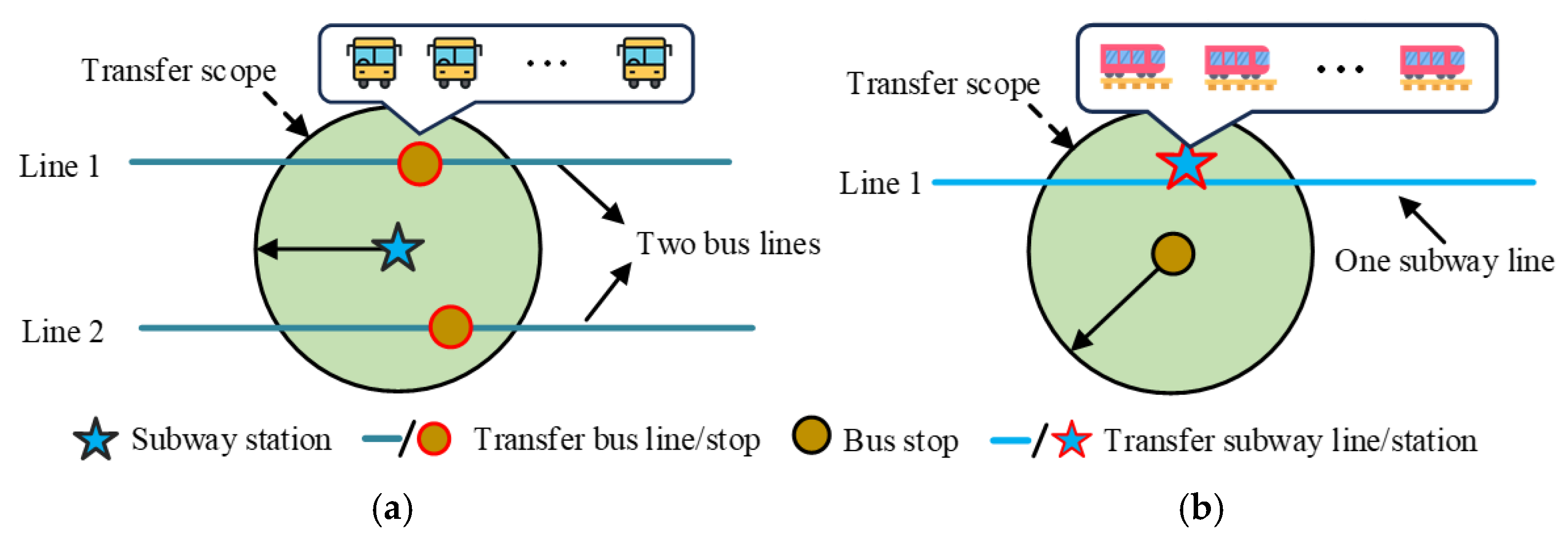
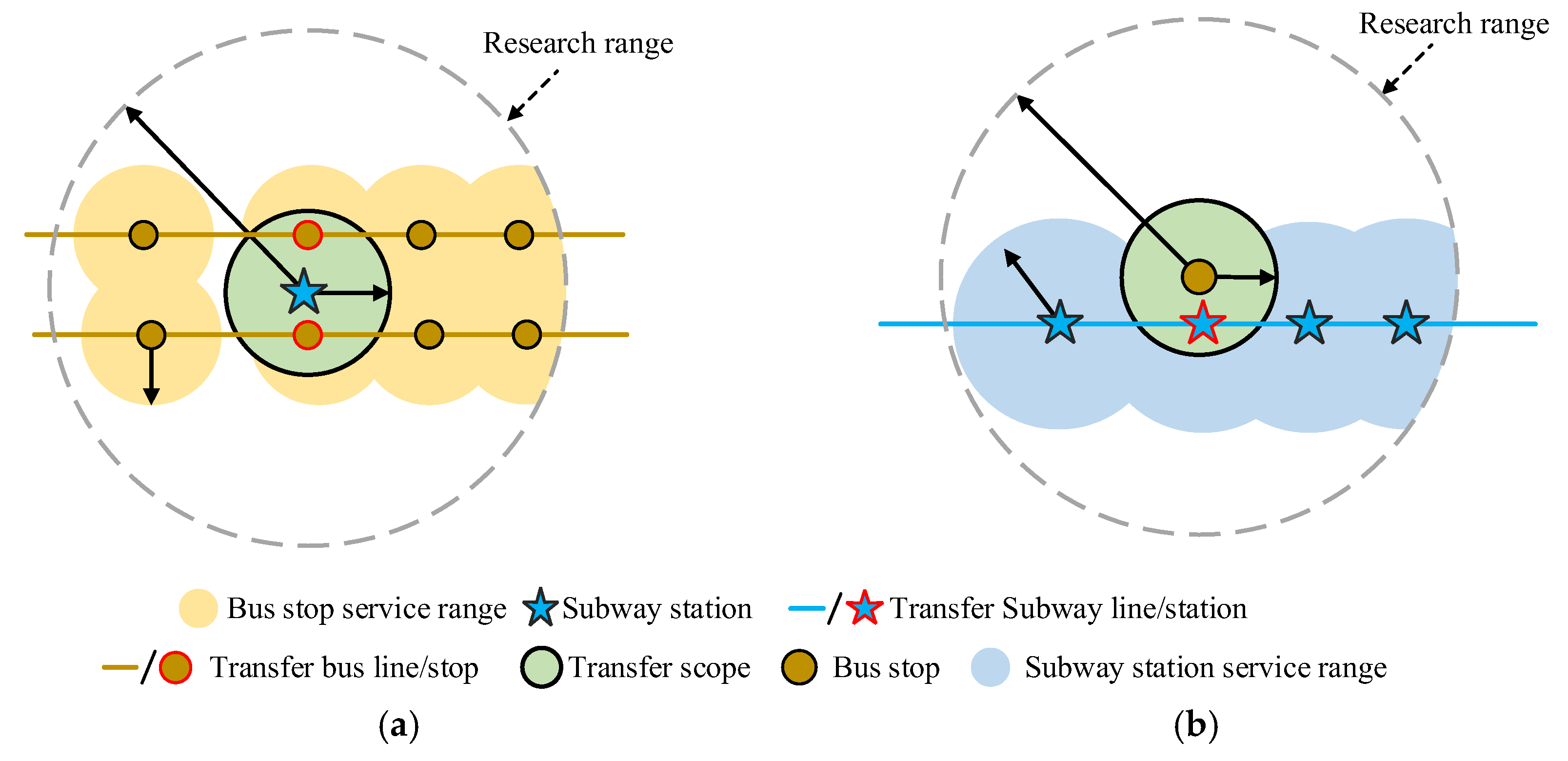



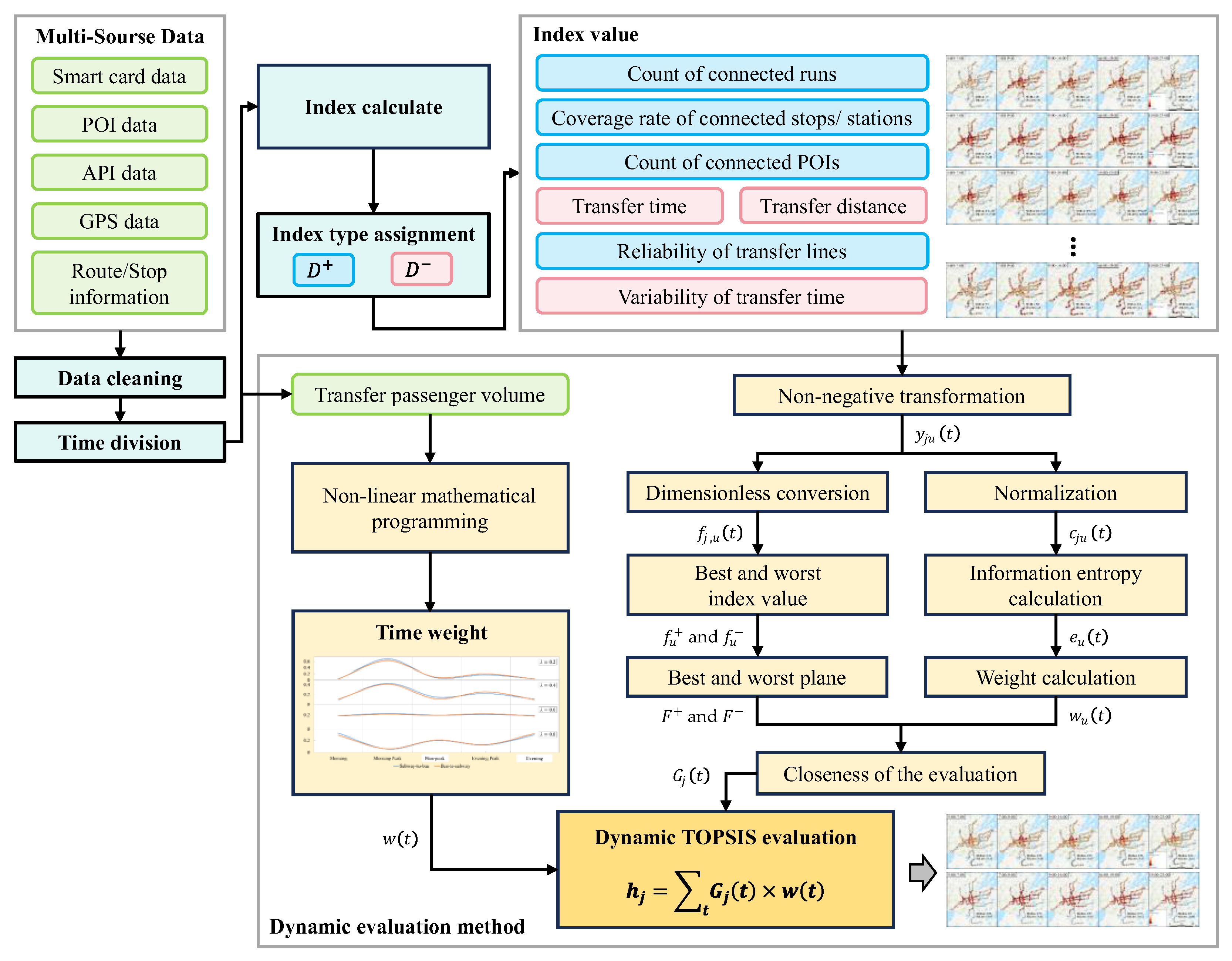
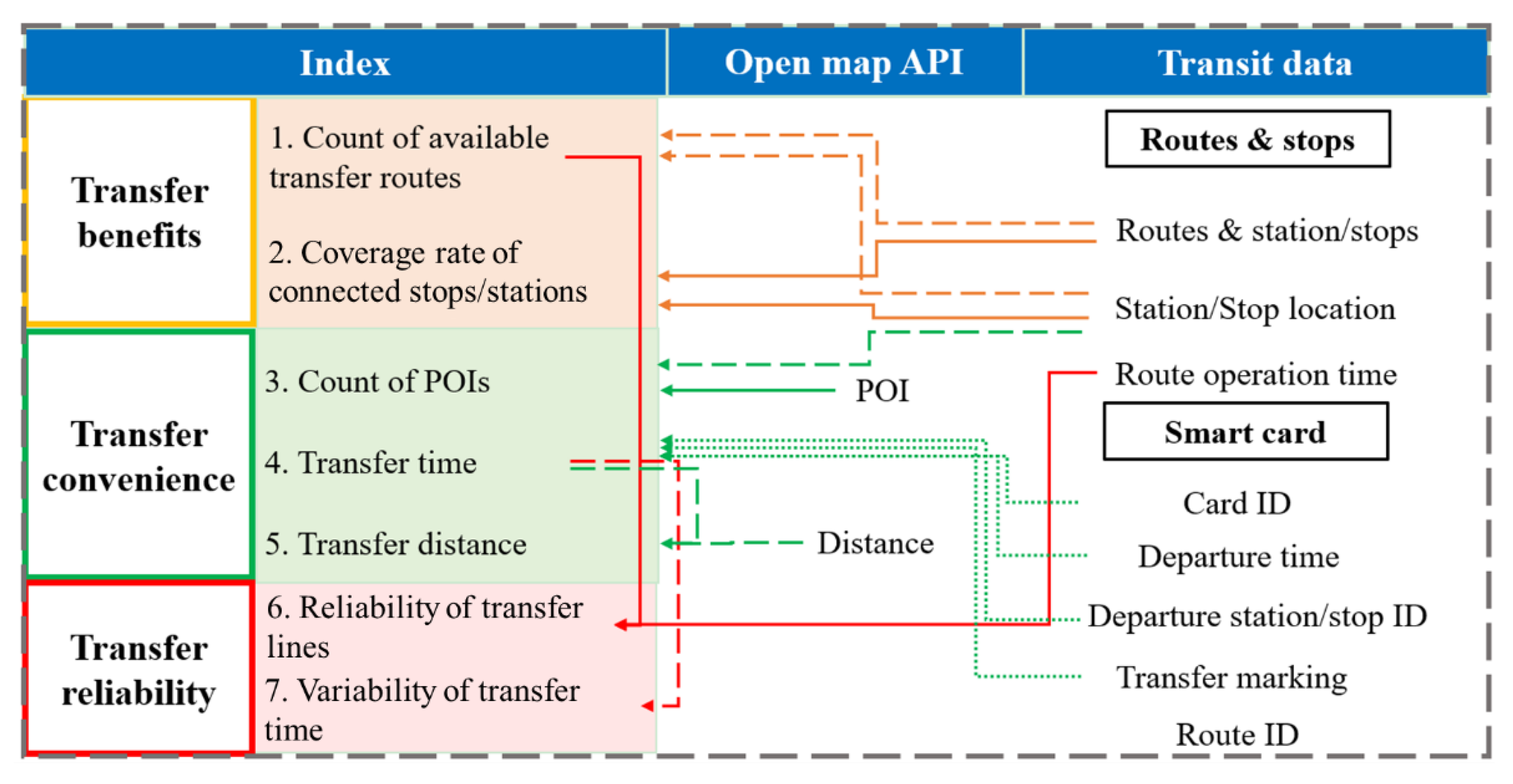
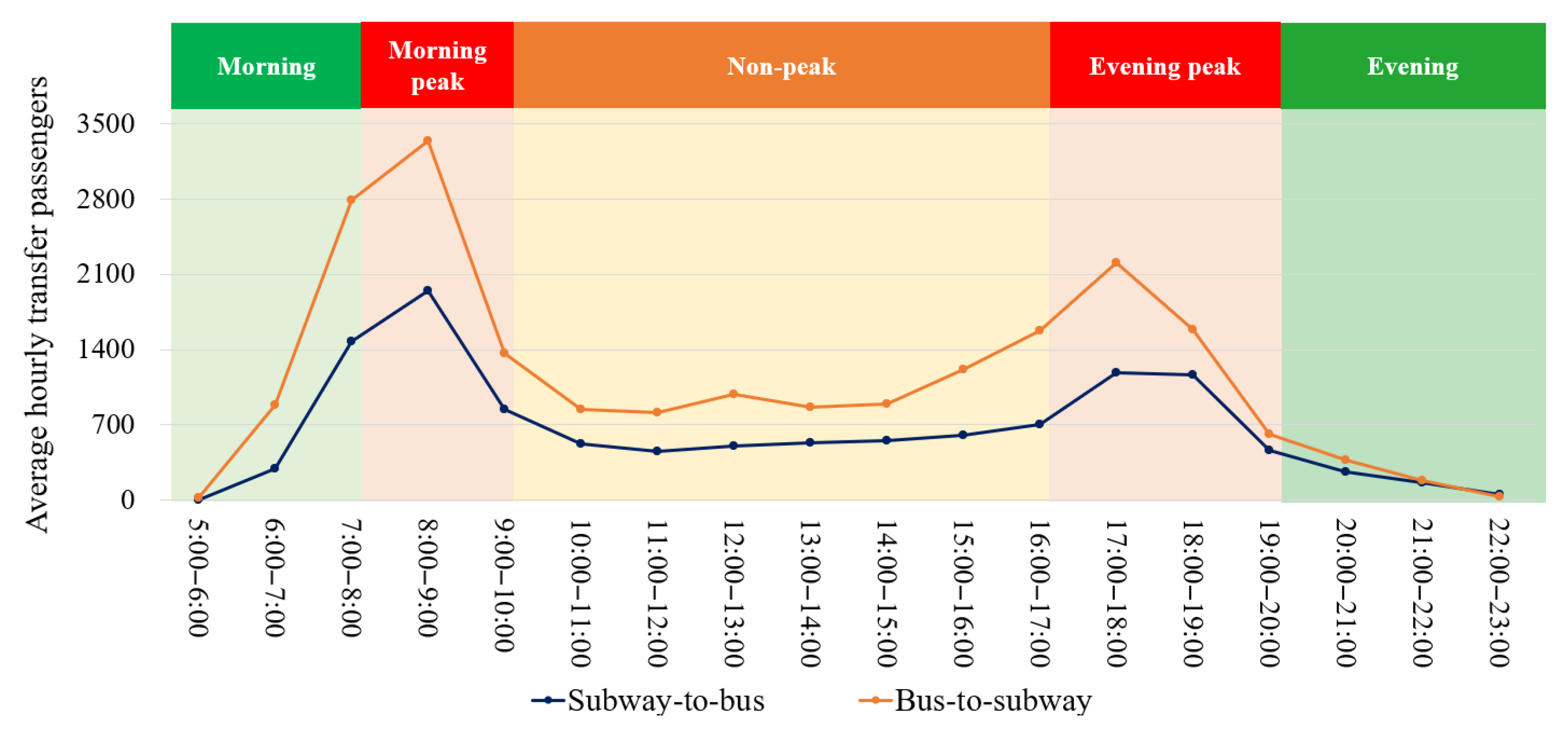



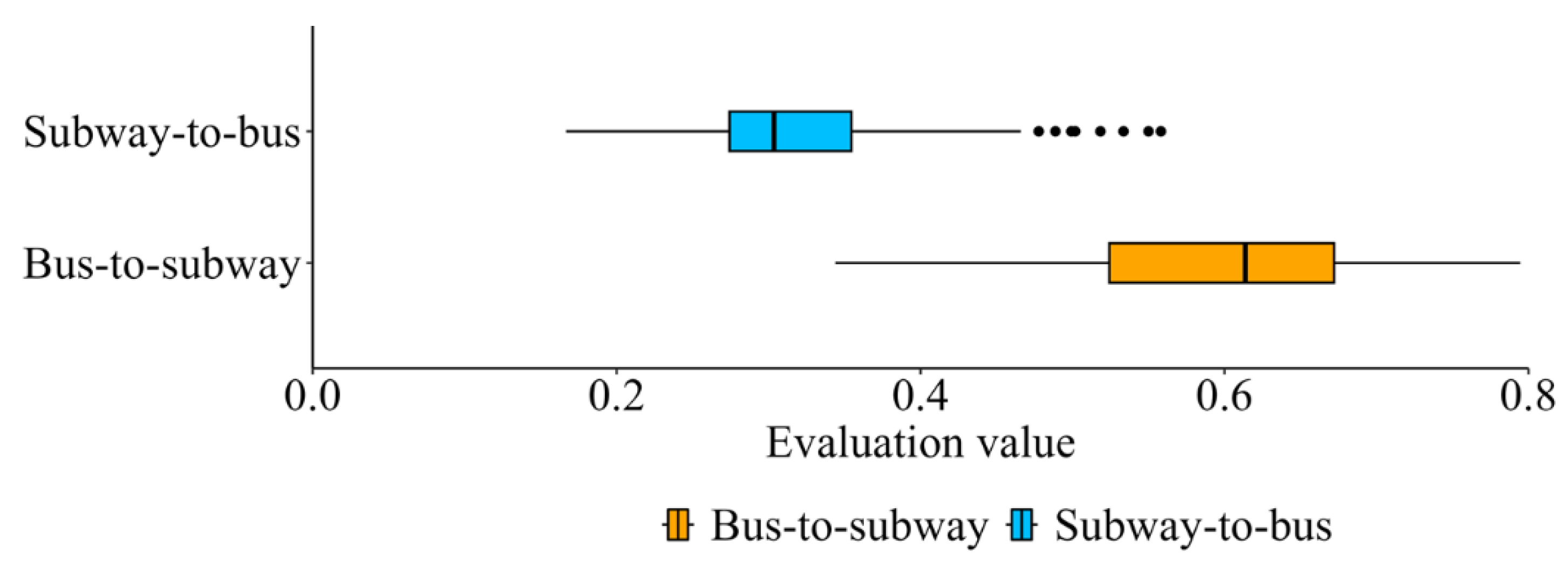
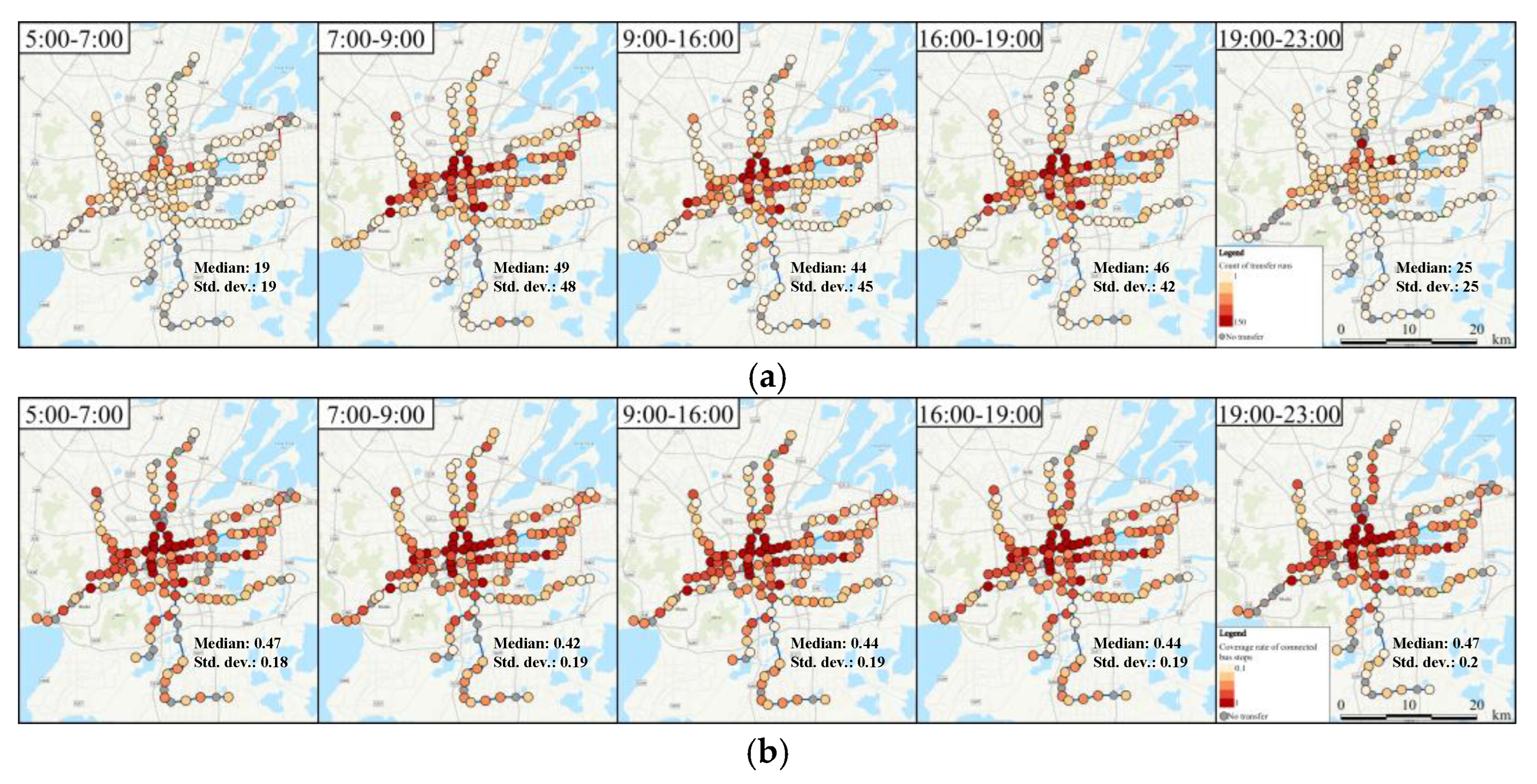

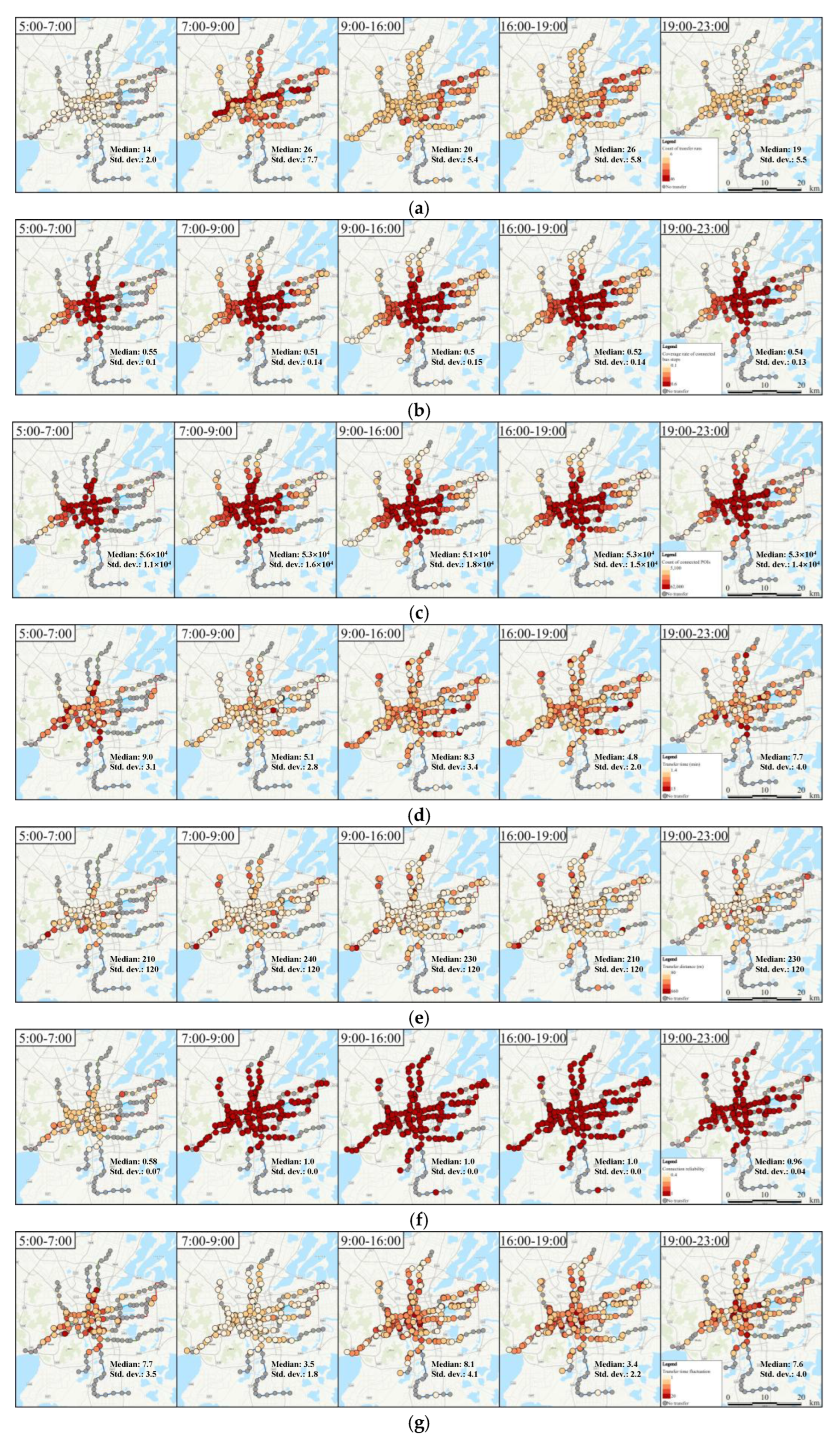


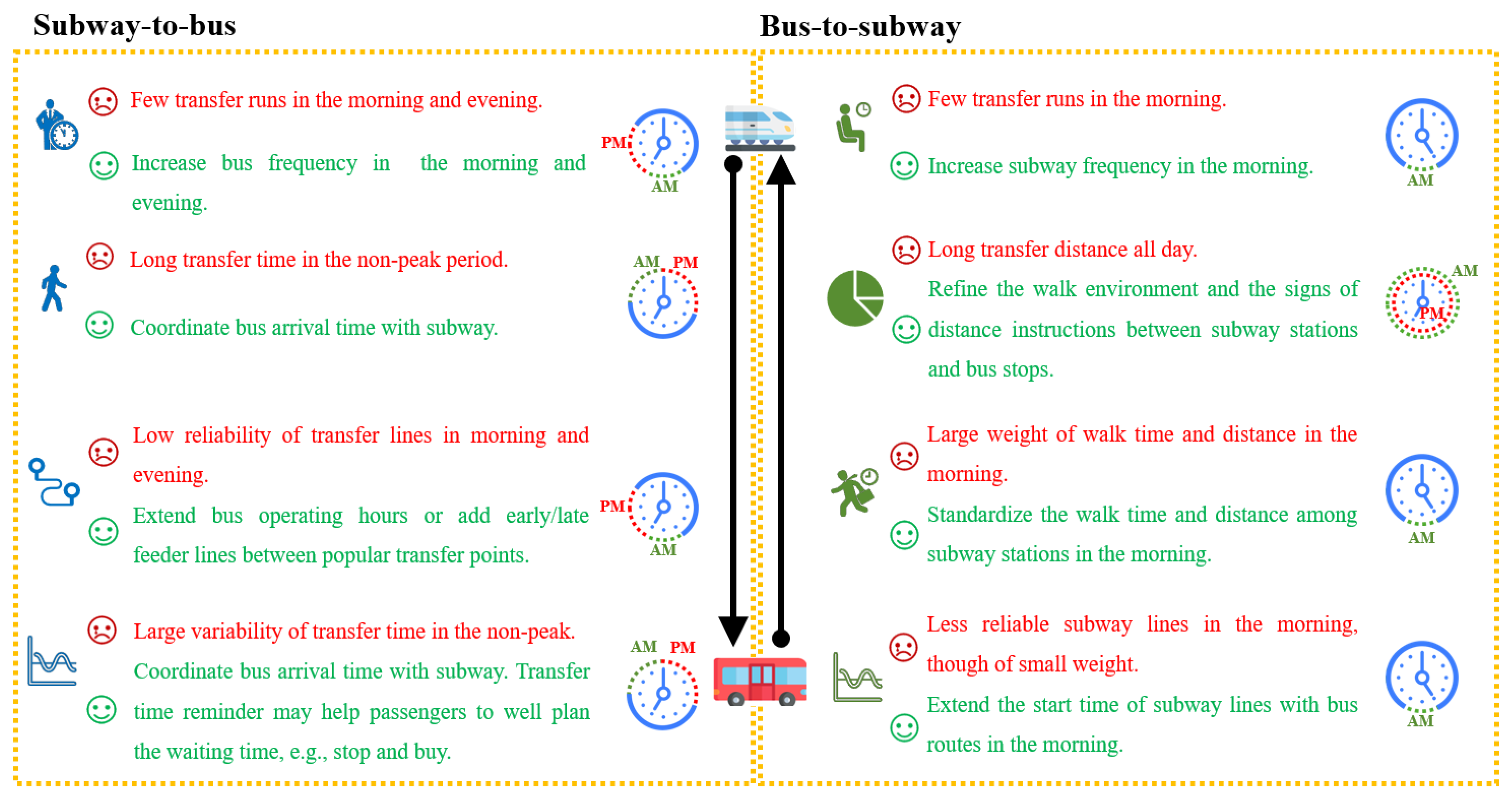
| Indices | Modes | References | Usage |
|---|---|---|---|
| Benefits | |||
| Count of transfer routes | All modes | 10, 19, 26, 27, 33 | Revised |
| POIs | Bus–subway, bus–bus | 9, 23, 26, 28 | Adopted |
| Coverage rate | Subway–bus | 25, 30, 32 | Adopted |
| Transfer cost | Subway–bus | 24 | - |
| Transfer volume | Bus–bus | 10 | - |
| Convenience | |||
| Transfer time | All modes | 10, 11, 16, 19, 23, 25, 26 | Adopted |
| Walking distance | All modes | 10, 11, 22, 23, 27 | Adopted |
| Ease of wayfinding | Bus–subway | 20 | - |
| Count of passageways | Bus–subway, bus–subway | 33 | - |
| Information | Bus–bus | 9 | - |
| Frequency | Bus–bus | 9 | - |
| Comfort | |||
| Safety | Subway–subway, bus–subway | 14, 18, 19, 20, 23 | - |
| Facility | Bus–subway | 19, 20 | - |
| Environment | Subway–subway, subway–bus | 16, 22 | - |
| Weather | Subway–bus, bus–subway | 23, 32 | - |
| Reliability | |||
| Reliability of connected lines | Subway–bus | 29, 30, 31 | Adopted |
| Variability of transfer time | Bus–bus, subway–bus | 9, 12, 13, 22 | Adopted |
| Indices | Explanation | Type |
|---|---|---|
| Benefits | ||
| Count of connected runs | Average number of buses or subways that can be taken within the transfer range in the specified period. | |
| Coverage rate of connected stops/stations | Ratio of the sum of the service area of the stops on the connected lines in operation to the research range in the specified period. | |
| Count of connected POIs | Count of distinct geographical points that one can be interested in. | |
| Convenience | ||
| Transfer time | Time when a passenger gets off the subway (or bus) before departing on a bus (or subway), weighed with transfer volume. | |
| Transfer distance | Distance between the transfer point and the departure point. | |
| Reliability | ||
| Reliability of transfer lines | Ratio of the routes in operation to the total routes connected to a transfer point. | |
| Variability of transfer time | Standard variation in the transfer time between subway and bus service. | |
Disclaimer/Publisher’s Note: The statements, opinions and data contained in all publications are solely those of the individual author(s) and contributor(s) and not of MDPI and/or the editor(s). MDPI and/or the editor(s) disclaim responsibility for any injury to people or property resulting from any ideas, methods, instructions or products referred to in the content. |
© 2025 by the authors. Licensee MDPI, Basel, Switzerland. This article is an open access article distributed under the terms and conditions of the Creative Commons Attribution (CC BY) license (https://creativecommons.org/licenses/by/4.0/).
Share and Cite
Jin, H.; Gao, J.; Shen, Z.; Cai, M.; Zhu, X.; Wu, J. Dynamic Evaluation for Subway–Bus Transfer Quality Referring to Benefits, Convenience, and Reliability. Sustainability 2025, 17, 6684. https://doi.org/10.3390/su17156684
Jin H, Gao J, Shen Z, Cai M, Zhu X, Wu J. Dynamic Evaluation for Subway–Bus Transfer Quality Referring to Benefits, Convenience, and Reliability. Sustainability. 2025; 17(15):6684. https://doi.org/10.3390/su17156684
Chicago/Turabian StyleJin, Hui, Jingxing Gao, Zhehao Shen, Miao Cai, Xiang Zhu, and Junhao Wu. 2025. "Dynamic Evaluation for Subway–Bus Transfer Quality Referring to Benefits, Convenience, and Reliability" Sustainability 17, no. 15: 6684. https://doi.org/10.3390/su17156684
APA StyleJin, H., Gao, J., Shen, Z., Cai, M., Zhu, X., & Wu, J. (2025). Dynamic Evaluation for Subway–Bus Transfer Quality Referring to Benefits, Convenience, and Reliability. Sustainability, 17(15), 6684. https://doi.org/10.3390/su17156684






